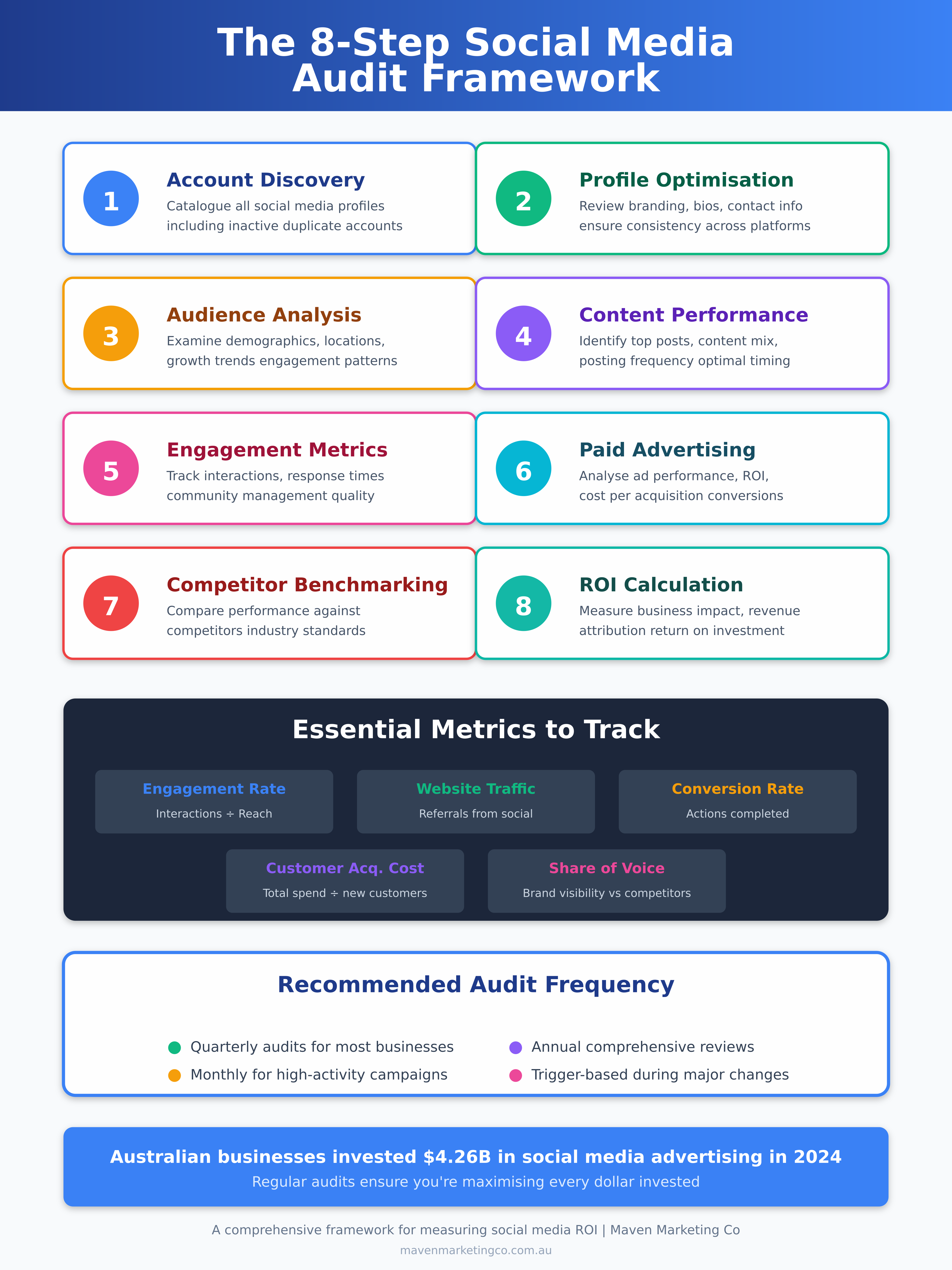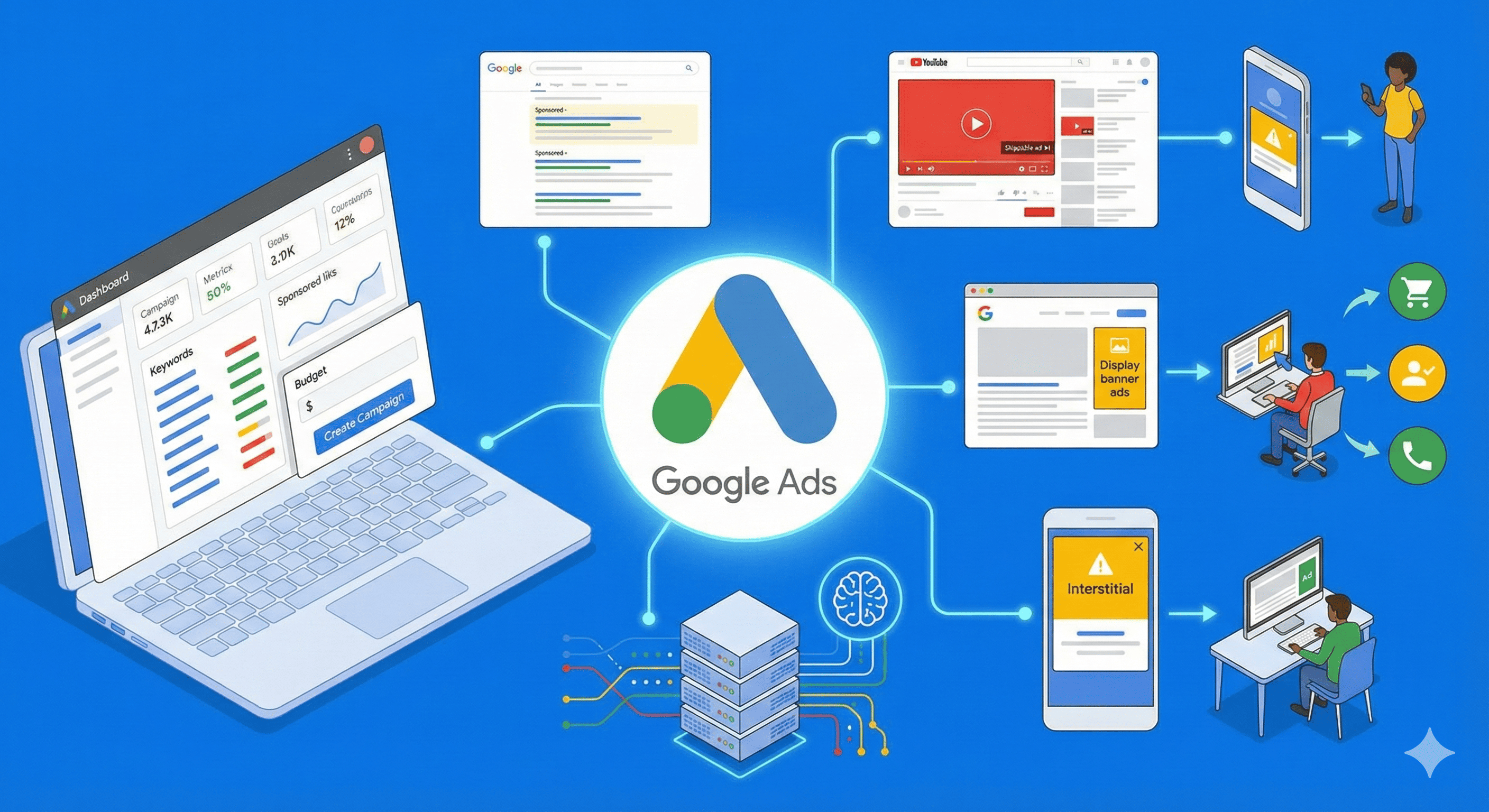
Australian businesses invested $4.26 billion in social media advertising during 2024, marking a substantial 12.1% increase from the previous year. With social media now commanding 29.3% of all digital ad spend, the question facing business owners and marketing managers isn't whether to invest in social platforms—it's whether those investments are actually delivering results.
A social media audit provides the answer. Far from being another corporate buzzword, a properly executed audit transforms scattered data points into actionable intelligence that reveals what's working, what's wasting budget, and where your biggest opportunities lie. For Australian businesses navigating an increasingly complex digital marketing landscape, regular auditing has evolved from optional best practice to competitive necessity.
Quick Answers: Social Media Audit Fundamentals
What is a social media audit and why do Australian businesses need one?
A social media audit is a comprehensive examination of your brand's presence across all platforms, evaluating profile optimization, content performance, audience demographics, engagement patterns, and ROI. With Australian businesses investing $4.26 billion in social media advertising and 87.8% of Australians using social platforms, audits reveal what's working, what's wasting budget, and where opportunities lie.
How often should businesses conduct social media audits?
Most Australian businesses benefit from quarterly audits, providing sufficient time to implement changes and observe results while maintaining oversight. Monthly audits suit businesses running intensive campaigns or in fast-moving industries, while annual comprehensive audits inform major strategic decisions. Trigger-based audits during rebrands, product launches, or significant performance changes provide immediate clarity.
What metrics matter most in a social media audit?
Focus on business-impact metrics: engagement rates (interactions divided by reach), website traffic and conversions from social sources, customer acquisition cost, return on ad spend, and revenue attribution. These metrics demonstrate actual business value, unlike vanity metrics such as follower counts or post likes that don't necessarily correlate with profitability.
How much does a social media audit cost?
DIY audits using free native platform analytics and spreadsheet templates cost only time investment. Professional audit services for Australian businesses typically range from $1,500-$5,000 depending on business size, number of platforms, and depth of analysis. The investment pays for itself when audit findings eliminate wasted ad spend and optimize underperforming campaigns.
Understanding Social Media Audits in the Australian Context
As of January 2025, 87.8% of Australia's population aged 18 and above uses social media, making Australia one of the most connected digital markets in the Asia-Pacific region. This remarkable penetration rate means your competitors are almost certainly active on these platforms, and your customers expect to find you there as well. According to Hootsuite's Digital 2025 Australia Report, Australian social media users are among the most active globally, with engagement rates consistently exceeding Asia-Pacific averages across major platforms.
A social media audit is a comprehensive examination of your brand's presence across all platforms. Unlike sporadic performance checks or quarterly reviews that merely glance at follower counts, a thorough audit systematically evaluates every aspect of your social media ecosystem. This includes profile optimisation, content performance, audience demographics, engagement patterns, competitor positioning, and crucially for business owners—return on investment.
Australians spend an average of 1 hour and 51 minutes per day on social media, with younger demographics spending significantly more time on platforms. That's nearly two hours daily when your brand could be connecting with potential customers, building relationships, and driving revenue. The audit process reveals whether you're capitalising on this opportunity or merely occupying digital space without strategic purpose.

The Business Case for Regular Auditing
Research demonstrates a compelling connection between structured social media management and profitability. Companies that regularly audit their social presence don't just feel more organised—they generate measurably better results. In 2024, 57% of Australians shopped on at least one social media site, yet many businesses struggle to translate social media activity into actual sales.
The audit process addresses this disconnect by illuminating the path from social engagement to business outcomes. Rather than celebrating vanity metrics like follower counts or post likes, audits focus on metrics that matter: website traffic from social sources, lead generation rates, conversion values, customer acquisition costs, and ultimately, revenue attribution.
Consider the reality facing Australian businesses today. Social commerce continues expanding rapidly, with consumers increasingly comfortable making purchases directly through social platforms. Brands spent $4.26 billion on social media advertising in 2024, up 12.1% from the previous year, with social now accounting for 29.3% of all digital ad spend. Without regular auditing, you're essentially flying blind whilst competitors use data-driven insights to optimise their approach.
When and How Often to Conduct Audits
The frequency of your social media audits should align with your business activity levels, resources, and strategic objectives. Most Australian businesses benefit from quarterly audits, which provide sufficient time between reviews to implement changes and observe results whilst maintaining close enough oversight to catch issues before they become costly problems.
For businesses running intensive campaigns or operating in fast-moving industries, monthly audits offer more granular insight. E-commerce brands during peak seasons, hospitality businesses responding to seasonal demand, or professional services firms launching new offerings often find monthly reviews essential for staying responsive to market dynamics.
Annual comprehensive audits serve a different purpose entirely. These deep-dive evaluations examine big-picture strategy, assess resource allocation across platforms, evaluate team performance, and inform major strategic decisions about platform selection and budget distribution for the coming year.
Trigger-based audits prove valuable during significant business transitions. Whether you're rebranding, launching major products, entering new markets, or noticing unexpected performance changes, an immediate audit provides the clarity needed for informed decision-making.

The Eight-Step Audit Framework
Effective social media audits follow a systematic approach that ensures nothing important gets overlooked whilst maintaining efficiency throughout the process.
Step One: Account Discovery and Documentation
Begin by cataloguing every social media presence associated with your business. This includes obvious accounts like your main Facebook page and Instagram profile, but also extends to regional pages, product-specific accounts, employee advocacy profiles, and any historical accounts that might still exist. Don't forget platforms you may have experimented with and abandoned—inactive profiles can still appear in search results and potentially confuse customers or damage brand perception.
Australian businesses often discover surprising findings during this initial step. Unofficial fan pages, impostor accounts, old promotional pages from discontinued campaigns, and duplicate profiles created by different team members all surface regularly. Document account URLs, login credentials, responsible team members, and current status for each profile.
Step Two: Profile Optimisation Review
Once you know what accounts exist, evaluate whether each profile presents your brand professionally and consistently. This evaluation covers multiple elements working in concert to create first impressions and establish credibility.
Visual branding requires consistency across platforms. Your logo should appear clearly in profile images, sized appropriately for each platform's specifications. Cover images or banners should reflect current branding and campaigns whilst maintaining professional quality. Outdated images featuring discontinued products, former team members, or superseded branding damage credibility more than missing images entirely.
Written elements demand equal attention. Business descriptions should communicate clearly what you do, whom you serve, and why people should care—all within character limitations imposed by each platform. Include relevant keywords naturally to support discoverability without resorting to keyword stuffing that reads poorly. Contact information must be current and complete, with phone numbers, email addresses, and physical locations accurate across all platforms.
Links deserve particular scrutiny. Your website URL should include UTM parameters that enable tracking which social platforms drive traffic and conversions. Many businesses link to their homepage across all platforms, missing opportunities to direct audiences toward specific landing pages, promotional offers, or conversion-optimised pages that would generate better results. Google's Campaign URL Builder provides a free tool for creating properly formatted UTM parameters, ensuring accurate tracking of social media traffic and attribution across all campaigns.
.jpg)
Step Three: Audience Analysis
Understanding who actually engages with your social presence often reveals gaps between your target market and your actual audience. Platform analytics provide demographic data including age ranges, gender distribution, geographic locations, device usage, and active times.
Facebook's ad reach in Australia was equivalent to 66.0% of the local internet user base in January 2025, making it particularly important for businesses targeting broader demographics. However, Instagram had 14.3 million users in Australia in early 2025, with 60% of Australian internet users engaging with Instagram, particularly among the 25-34 age group who use the platform as a discovery tool.
Compare your audience data against your ideal customer profiles. If you're targeting professional decision-makers but your Instagram audience skews heavily toward students, you're either on the wrong platform or using ineffective content strategies. Geographic data proves especially valuable for businesses with physical locations or regional service areas—advertising to audiences outside your serviceable area wastes budget.
Audience growth trends reveal whether your organic reach is expanding, stagnating, or declining. Sudden follower spikes warrant investigation—they might indicate successful campaigns or potentially fraudulent bot follows that artificially inflate numbers without adding genuine engagement.
Step Four: Content Performance Evaluation
Your content is the engine driving all social media results. This section of the audit identifies what resonates with your audience and what falls flat, providing the intelligence needed to refine your content strategy.
Examine content mix across different formats. What percentage of your posts are photos versus videos? How often do you share links to external content compared to native content? Are you leveraging platform-specific features like Instagram Stories, LinkedIn articles, or Facebook Live? Recent data shows that Australians are watching more short-form video content than ever, with an average of 4.4 hours spent on it per week compared to 3.1 hours in 2022, suggesting video content deserves increased priority.
Identify your top-performing posts by engagement, reach, and conversions. Look beyond surface-level metrics to understand why certain content succeeds. Was it the topic, the format, the posting time, the caption style, or some combination of factors? Conversely, analyse underperforming content to understand what doesn't resonate with your audience.
Posting frequency and timing patterns influence results significantly. Too frequent posting can overwhelm audiences and trigger unfollows, whilst too infrequent posting causes your brand to disappear from feeds entirely. Timing analysis reveals when your specific audience is most active and receptive to content.
Step Five: Engagement Metrics and Community Management
Engagement metrics reveal how audiences interact with your content, providing insight into content quality and audience interest levels that raw reach numbers cannot capture.
Track engagement rates by calculating total interactions (likes, comments, shares, saves) divided by reach or impressions. This ratio indicates content resonance independent of audience size, enabling fair comparisons between posts with different reach levels. Response rates and sentiment analysis show how effectively you're building relationships and managing your community.
Review your response times to comments and messages. Platforms like Facebook, Instagram, and TikTok are becoming increasingly important channels for social commerce, with about 5.3 million of Australian internet users already shopping on social media, making responsive customer service through social channels increasingly important for conversion.
Customer service interactions deserve particular attention. Are inquiries being answered promptly and professionally? Do responses align with your brand voice? Are recurring questions surfacing that suggest content gaps or product information needs? Social media increasingly functions as a customer service channel, and your performance here directly impacts satisfaction and retention.

Step Six: Paid Advertising Performance
If you're investing in social media advertising—and with ad spending on social media advertising in Australia projected to reach $3.9 billion in 2024, many Australian businesses are—rigorous evaluation of paid performance is non-negotiable.
Analyse each campaign's reach, impressions, click-through rates, and conversion rates. Calculate cost per click, cost per acquisition, and return on ad spend. These metrics reveal whether your advertising investment generates positive returns or consumes budget without delivering proportional value.
Compare paid performance across different platforms, audience segments, and creative approaches. Often, businesses discover that certain platforms deliver dramatically better ROI than others, or that specific audience segments convert at rates justifying increased investment whilst others prove unprofitable.
Creative performance analysis identifies which ad formats, images, videos, headlines, and calls-to-action drive best results. This intelligence informs future campaign development, enabling continuous improvement of your advertising effectiveness.
Step Seven: Competitor Benchmarking
Your social media performance exists within a competitive context. Understanding how your metrics compare to competitors provides crucial perspective on whether your results represent success or indicate areas requiring improvement.
Identify three to five direct competitors and document their social media presence. Note which platforms they prioritise, their posting frequency, content types, engagement levels, and distinctive strategic approaches. While you can't access their private analytics, publicly visible metrics like follower counts, post engagement, and content performance provide valuable benchmarking data.
This competitive intelligence often reveals opportunities competitors haven't capitalised on, content gaps in the market, or successful tactics worth adapting to your own strategy. Perhaps competitors excel on LinkedIn but ignore Instagram, or maybe they've built engaged communities around specific content themes you could also explore.
Step Eight: ROI Calculation and Business Impact
The ultimate question every social media audit must answer is simple but crucial: does our social media activity generate positive return on investment?
Calculate total social media investment including advertising spend, content creation costs, team salaries, tools and software subscriptions, and any agency or consultant fees. Then measure returns across multiple dimensions.
Direct revenue attribution tracks sales that originated from social media channels. Use UTM parameters, platform-specific tracking pixels, and analytics platforms to follow the customer journey from social interaction to purchase. E-commerce businesses can often track this directly, whilst service businesses might measure lead generation and calculate conversion values based on historical close rates.
Indirect value contributions include brand awareness metrics, customer service cost savings from handling inquiries through social channels, content marketing value when social posts rank in search results, and community building that supports retention and referrals.
Website traffic from social sources should be evaluated not just by volume but by quality. Examine bounce rates, pages per session, time on site, and conversion rates for social traffic compared to other channels. High traffic with poor engagement suggests misalignment between social content and landing page expectations.

Essential Metrics for Australian Businesses
Different business types and industries require different metric priorities, but several key performance indicators prove universally valuable for Australian businesses measuring social media ROI.
Engagement Rate measures the percentage of your audience actively interacting with content. Calculate this by dividing total engagements by reach or impressions. Healthy engagement rates vary by platform and industry, but consistently low engagement suggests content isn't resonating regardless of how many followers you've accumulated.
Reach and Impressions indicate how many people see your content and how often. Reach counts unique users, whilst impressions track total views including multiple views by the same users. Expanding organic reach without paid promotion indicates content quality and algorithmic favour.
Website Traffic and Conversions from social sources directly demonstrate business impact. Track not just clicks but also behaviour after arrival—do social visitors explore your site, consume content, and convert at rates comparable to other traffic sources?
Customer Acquisition Cost from social channels compares favourably against other marketing channels when calculated accurately. Include all social media costs divided by new customers acquired through social channels.
Share of Voice measures your brand's visibility within your industry or category compared to competitors. This metric helps assess whether your social presence is growing, maintaining, or losing ground within your competitive landscape.
Customer Lifetime Value of social media-acquired customers often differs from customers acquired through other channels. Some businesses find social customers engage more frequently and refer more often, whilst others discover social acquisition costs don't justify the long-term value. Only thorough tracking reveals these patterns.
Tools and Templates for Efficient Auditing
Conducting comprehensive audits manually would consume unreasonable time and effort. Fortunately, numerous tools streamline the process whilst maintaining thoroughness and accuracy.
Native platform analytics provide the starting point for most audits. Facebook Business Suite, Instagram Insights, LinkedIn Analytics, and Twitter Analytics offer detailed performance data directly from each platform. These tools are free, accurate, and comprehensive, though they require switching between platforms to compile complete pictures.
Third-party analytics platforms like Sprout Social, Hootsuite Analytics, or Buffer Analyze aggregate data across multiple platforms into unified dashboards. These tools save time, enable easier comparison, and often provide deeper analysis than native tools alone.
Spreadsheet templates create structure and consistency across multiple audits. Document platforms, track metrics over time, and maintain historical data for trend analysis. Templates ensure you examine the same elements each audit cycle, enabling meaningful comparison.
Social media management platforms often include audit functionality alongside scheduling, engagement, and reporting features. Platforms like Statusbrew or ClickUp offer templates specifically designed for social media audits with customisable fields for tracking metrics relevant to your business.
Google Analytics remains essential for measuring website traffic from social sources, tracking conversions, and understanding user behaviour after social media referrals. Proper UTM parameter implementation ensures accurate attribution and enables detailed analysis of which social campaigns drive most valuable traffic.
Turning Audit Findings into Action
Data collection means nothing without translation into strategic action. The most valuable audits culminate in clear, prioritised recommendations that guide immediate improvements and inform long-term strategy.
Identify quick wins that deliver immediate impact with minimal resource investment. Perhaps you discover certain posting times generate significantly better engagement, or specific content formats consistently outperform others. Implement these changes immediately whilst planning more substantial strategic shifts.
Address critical issues that actively harm performance. Inactive accounts confusing customers, outdated profile information, broken links, or poor customer service response times require urgent correction before they continue damaging your brand reputation.
Plan strategic improvements for longer-term implementation. Platform diversification, content strategy overhauls, team training needs, or budget reallocation across channels might require planning, resources, and phased rollouts but promise significant performance improvements.
Set specific, measurable goals informed by audit findings. Rather than vague aspirations to "improve engagement," commit to increasing engagement rates by 25% over the next quarter on Instagram whilst maintaining or improving engagement quality. Specific targets enable progress tracking and accountability.
Document your audit findings, recommendations, and implementation plans. Share reports with stakeholders including leadership, team members, and any external partners. Transparency around performance realities, even when results disappoint, builds credibility and secures necessary support for improvements.
Common Pitfalls to Avoid
Even well-intentioned audits can mislead when certain common mistakes occur. Awareness of these pitfalls helps ensure your audit process generates reliable intelligence.
Vanity metrics trap many businesses into celebrating meaningless numbers. Follower counts, post likes, and total reach create positive feelings but don't necessarily correlate with business outcomes. An account with 50,000 followers generating minimal website traffic and zero sales delivers less value than an account with 5,000 highly engaged followers driving consistent conversions.
Inconsistent measurement periods make comparison impossible. If you audit quarterly but include varying date ranges, track different metrics each cycle, or change calculation methods, you can't accurately assess progress. Consistency in timing, metrics, and methodology enables meaningful trend analysis.
Ignoring platform-specific contexts leads to unfair comparisons. LinkedIn engagement rates naturally run lower than Instagram, but LinkedIn's professional audience might convert at dramatically higher rates. Each platform serves different purposes and reaches different audiences, requiring evaluation against appropriate benchmarks.
Confirmation bias tempts businesses to emphasise data supporting existing beliefs whilst dismissing contradictory findings. If you're convinced TikTok is the future but audit data shows minimal ROI, objectively assess whether the platform suits your business or whether you're simply executing poorly. Good audits sometimes deliver uncomfortable truths requiring strategic pivots.
Analysis paralysis occurs when businesses collect extensive data but never translate findings into action. Perfect information doesn't exist, and waiting for complete certainty before making changes means competitors improve whilst you deliberate. Conduct thorough analysis, make informed decisions, implement changes, then measure results to validate or adjust your approach.

The Future of Social Media Measurement
Social media platforms continuously evolve, introducing new features, changing algorithms, and shifting user behaviours that impact how Australian businesses should measure success.
Privacy regulations increasingly limit tracking capabilities, requiring businesses to rely more heavily on first-party data and platform-native analytics. Adaptation requires investing in customer relationship management systems, building owned audiences through email lists and communities, and developing measurement frameworks less dependent on cross-platform tracking.
Artificial intelligence and machine learning increasingly power social media algorithms and analytics tools. Understanding these technologies helps businesses optimise content for algorithmic distribution whilst using AI-enhanced analytics for deeper insights into audience behaviour and content performance.
Social commerce continues expanding, with platforms introducing native shopping features, in-app checkout, and shoppable content formats. Measurement frameworks must evolve to track these new conversion paths and attribute revenue accurately across increasingly complex customer journeys.
Short-form video dominates content consumption, requiring businesses to adapt both creation strategies and measurement approaches. Traditional metrics like link clicks matter less on video-first platforms, whilst watch time, completion rates, and saves gain importance.
Taking Action: Your Next Steps
Understanding social media audit methodology means little without actual implementation. If you've never conducted a formal audit, start now. If you audit sporadically, commit to regular scheduling. If you audit regularly, evaluate whether your process captures all critical elements discussed in this guide.
Begin with accessible tools and simple frameworks. You don't need expensive enterprise software to conduct your first audit—native platform analytics, a spreadsheet template, and dedicated time provide everything necessary for valuable insights.
Focus on metrics that directly connect to business outcomes. Revenue attribution, lead generation, customer acquisition costs, and website conversion rates matter far more than follower counts or post likes. Build measurement frameworks around these business-critical indicators.
Commit to regular review cycles that suit your business pace and resources. Quarterly audits work well for most businesses, providing sufficient data between reviews whilst maintaining close enough oversight to identify and address issues before they become critical.
Share findings widely within your organisation. Social media performance impacts marketing effectiveness, customer service quality, sales pipeline development, and brand perception. Cross-functional visibility into social media audits ensures coordinated improvement efforts and prevents siloed thinking.
Transform Your Social Media ROI
Social media marketing in Australia has matured far beyond posting content and hoping for engagement. With billions invested in social advertising and 77.9% of Australians active on social media platforms, professional, data-driven management separates businesses generating genuine returns from those merely occupying digital space.
Regular auditing transforms social media from cost centre to revenue driver by illuminating what works, eliminating what doesn't, and continuously optimising your approach based on actual performance data rather than assumptions or best practices designed for different businesses in different markets.
The question facing Australian businesses isn't whether to invest in social media—that decision is essentially made by customer expectations and competitive realities. The real question is whether you'll invest strategically, measuring rigorously, and optimising continuously to ensure every dollar and hour spent generates proportional returns.
Your competitors are conducting audits, optimising performance, and improving results whilst any business neglecting this fundamental practice slowly loses ground. The audit process isn't optional for businesses serious about digital marketing success—it's the foundation enabling everything else to work effectively.

Ready to Maximise Your Social Media Investment?
Conducting thorough social media audits requires expertise, time, and objectivity that many Australian businesses struggle to maintain internally. Team members too close to daily execution often miss strategic issues, whilst business owners juggling multiple priorities rarely find time for the deep analysis effective auditing demands.
Maven Marketing Co specialises in comprehensive social media audits that reveal exactly where your social media marketing succeeds, where it underperforms, and most importantly—how to improve ROI across every platform and campaign. Our team combines platform expertise, analytics capabilities, and strategic thinking to transform social media from uncertain investment to measurable business driver.
We don't just deliver reports filled with data—we provide actionable roadmaps for improvement, prioritised recommendations aligned with your business goals, and ongoing support implementing changes that generate real results. From local businesses building community presence to national brands optimising multi-platform strategies, we help Australian businesses extract maximum value from social media investment.
Stop guessing whether your social media marketing works. Contact Maven Marketing Co. today to discover how our social media audit services can illuminate your path to measurable ROI and sustainable digital marketing success.









